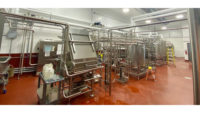The acid whey conundrum
A byproduct of Greek yogurt manufacturing, acid whey presents an environmental challenge that will require the combined efforts of many parties to resolve.

Photo courtesy of DuPont Nutrition & Health



Over the past decade, the dairy industry has experienced a boom in the production of Greek-style yogurt (GSY). While in 2004 GSY accounted for less than 2% of all yogurt types produced domestically, by 2015 this number skyrocketed to almost 40%1.
The product is very well-received by consumers because of its high protein content, which provides appealing nutritional and organoleptic properties, with minimal or no additives. However, the straining associated with its manufacturing leads to the generation of high quantities of a bright green byproduct: acid whey. For every kilogram of GSY, 2 to 3 kilograms of acid whey are produced. In 2015, the total amount of acid whey produced summed up to a staggering 2 million tons in the United States1.
While sweet whey, the byproduct from rennet cheeses, can be turned into protein powders targeted toward sports nutrition and protein fortification of foods and beverages, acid whey is considered much less valuable because of its low protein content, high mineral content and low pH. If directly disposed, acid whey can have a negative impact on the environment because of its high biologic oxygen demand (BOD) and mineral content.
Current applications include irrigation, feed and energy generation. Dairy processors have yet to find a feasible way to incorporate it into higher-end products. Nevertheless, since it contains important components such as lactose and minerals, acid whey or some of its components could be used in fermented goods, sports beverages, dairy products, snacks and specialty products. Several researchers and companies are actively investigating solutions for the acid whey problem, so far with limited success2.
New York state, in particular, is a big player on the national scene in terms of acid whey production, since it is leading the manufacturing of cream cheese and GSY. In 2012 alone, New York produced almost 700 million pounds of GSY3.
Cornell University scientists recently conducted a survey of dairy companies in New York state that produce acid whey, with funding from the New York State Department of Environmental Conservation. Of the 11 companies surveyed, 10 stated that acid whey has actual or potential value. The same survey highlighted that there is a lack of information regarding the composition and physicochemical parameters of this byproduct, which limits the ability to develop good solutions for its utilization. To assist the effort of identifying solutions for acid whey utilization, a composition panel of acid whey from both GSY and cottage cheese is presented in the table on page 42.
The concentration of crude protein in acid whey from GSY is very low and variable, ranging from 0.17% to 0.37%. Alpha-lactalbumin, a potentially valuable protein component in acid whey, also had very low and highly variable levels (0.17 to 0.77 milligrams/liter). Although somewhat smaller, protein levels in GSY acid whey were comparable to those of the acid whey from cottage cheese.
By comparison, the protein content in sweet whey usually ranges from 0.6% to 1%; pH is typically around 6.3; and calcium levels are between 400 and 600 parts per million (ppm)4,5. Acid whey’s low protein content, along with low pH and high mineral content, renders its processing very challenging.
Solving the acid whey issue in an economically and environmentally sound manner will require the combined efforts of farmers, dairy scientists, engineers, environmental researchers, nutritionists, product developers, government and industry. We hope that the composition data included here will assist those involved with acid whey production and handling make informed decisions about value-added applications in the future.
1. Erickson, B. (2017). “Acid whey: Is the waste product an untapped goldmine?” Chemical & Engineering News, https://tinyurl.com/ydz5f9ha.
2. Arla Foods Ingredients. (2017). https://tinyurl.com/yd9uofza.
3. New York State Department of Environmental Conservation. (2012). “Whey Management for Agriculture, ”www.dec.ny.gov/chemical/94164.html.
4. Huma, N., Pasha, I., Sarwar, M., Ahmad, S., and Shah, F. (2015). Effect of Different Filtration Membranes on Composition of Sweet and Acid Whey Protein, 25(2), 79–85.
5. Jelen, P. (2011). Whey Processing, 731–737.
Looking for a reprint of this article?
From high-res PDFs to custom plaques, order your copy today!







